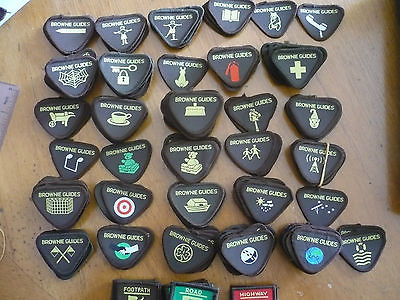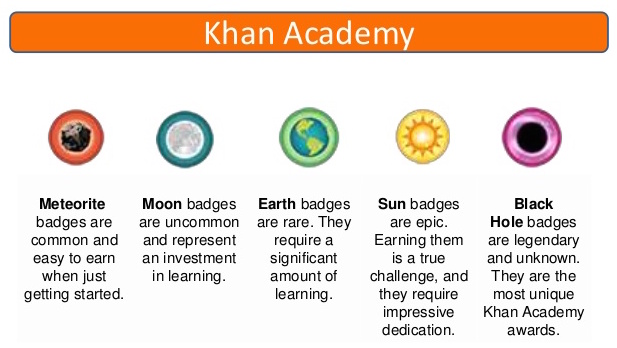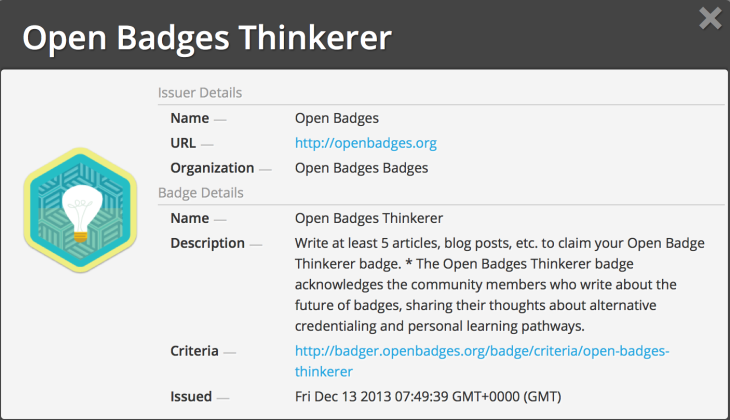As CIPD increasingly experiments with free and low cost digital learning (see the forthcoming Future of Learning course – developed with Home Learning College, and our first MOOC: Working Digitally: Social Media and HR), we’ve been thinking about how we incentivise and accredit those courses. Hence this week’s musings on Open Badges.
Analogue badges
I don’t know about you, but when I was a kid I loved badges. In fact one of the (few!) things I liked about being a brownie was all those badges sewn on to my uniform. (Although I never did get the Needleworker or the Hostess badges!) We children of the late 70s/early 80s were spoiled for badges: my Adidas tracksuit fairly bristled with various BAGA gymnastics badges and International STA swimming badges.

Digital badges
That analogue yearning to earn, collect and display badges for participation and achievement is no less acute in our digital lives. Particularly in the spheres of learning (for example Kahn Academy) and collaboration, and especially in order to ‘gamify’ online activities: the pre-eminent example being Microsoft Xbox’s 360 Gamescorer system. But digital badges appear all over the internet, two great examples are TripAdvisor (contributions) and FourSquare (check ins).

What’s wrong with digital badges?
Kahn Academy, Xbox’s Gamescorer, FourSquare and TripAdvisor are all examples of closed badging systems, meaning you can’t display badges you’ve earned within a particular platform elsewhere on the web. Digital badges just aren’t interoperable, they’re not transferable between systems.
Another issue with digital badges is their validity and credibility: how can an pixel-generated icon represent a ‘trusted credential’?
Open badges to the rescue
Open badges are similar to, but not to be confused with digital badges. In 2011 Mozilla (the chaps behind the FireFox internet browser) started work on an open source framework that supports web-based badges to solve the issues of validity and interoperability.

Valid and credible badges
Open badges aren’t just icons. Embedded within each badge image is a set of metadata that describes (amongst other things) how, where and when it was earned, who earned it, and who issued it.
What’s metadata you might ask?
Metadata is structured information that describes, explains, locates, or otherwise makes it easier to retrieve, use, or manage an information resource. Metadata is often called data about data or information about information. (Niso)
This wonderful illustration by Kyle Bowen neatly strips back the metadata that sits behind an open badge.

The metadata can then be viewed by anyone wishing to check up on a person’s credentials, or just to find out more about the badge.

Image courtesy of Open Badges 101 course.
Interoperable badges
Mozilla’s open badge infrastructure is an open standard. Essentially this means open badges are:
- Free and open: Mozilla Open Badges is not proprietary. It’s free software and an open technical standard any organization can use to create, issue and verify digital badges.
- Transferable: Collect badges from multiple sources, online and off, into a single backpack. Then display your skills and achievements on social networking profiles, job sites, websites and more.
- Stackable: Whether they’re issued by one organization or many, badges can build upon each other and be stacked to tell the full story of your skills and achievements.
From Mozilla’s Open Badge Wiki.
On the issuer side of things Mozilla’s BadgeKit includes all the tools an organisation or an individual needs to create, design, assess and issue badges.
For the earners, their badges are can be stored anywhere, even your own computer, but it’s most practical to collect them up in a ‘backpack’. (Why not an adidas tracksuit I couldn’t say.)
Mozilla’s backpack is a repository for the collection, management and display of your badges. (And because it’s a federated, open ecosystem, Mozilla have made the source code for both BadgeKit and Backpack publicly available, so other providers can develop their own versions.)
From your backpack badges can be embedded and displayed across numerous platforms (including Moodle, Mahara and WordPress) and social media sites. (A little like videos can be embedded across different sites, but are hosted on YouTube.)
Badge thinking at CIPD
We’ve a way to go yet before we work out our (open) badge strategy at CIPD. Although we’ll be starting out by issuing badges for various activities on the Future of Learning course, for example for curating great content and writing insightful blogs and posts.
But some of the things we might issue badges for are:
- Participation in CIPD’s community platform
- Completion of a MOOC
- Participation in a webinar
- Speaking at a CIPD conference or event
- Completion of CPD
We’re going to need to think carefully about our badge taxonomy and learning pathways, and things like how we might reward and integrate offline activities such as participation in programmes such as Steps Ahead Mentoring or volunteering at Branch events.
So this is all work in progress, and I’ll be blogging more about the Open Badges initiative at CIPD in the coming months.
And finally, a confession
I’m part way through the Think Out Loud club‘s excellent Open Badges 101 course. Highly recommended for anyone wanting to find out more about open badges.
With this blog, I’m hoping to earn my first digital badge with the 101 Course, to put it in my backpack, and display it on my LinkedIn page. Whaddyathink: should I get my badge?


A well written blog covering the subject well. I am thrilled that CIPD are joining the badging world, I hope it goes well for you. As a backup to the 101 course I have an e-book which you are welcome to use:
http://huxleypiguk.blogspot.co.uk/2015/07/free-open-badge-e-book.html
Please contact me via http://about.me/bob.price if I can help you with anything
Kind regards
Bob Price
LikeLike
did you get your badge Sarah? You should have!!!
LikeLike
I did! It’s an excellent course. Recommended.
LikeLiked by 1 person
Thanks for the heads up on the Open Badges 101 course Sarah. This is a great introduction to badges.
Currently I’m looking at using Badges for tracking the completion of compliance training. One of the great things about the metadata stored in badges is that you can set badges to expire, which fits with a lot of compliance training programmes. In the case of compliance training users, and the business may not necessarily get any benefit from the open element and so I’m currently modelling the process as a non-open badge, but one that is purely issued internally. As we gain more experience, I hope to start using more Open Badges
You are right that we need to discuss taxonomies and metadata though. It’s easy to get
LikeLike